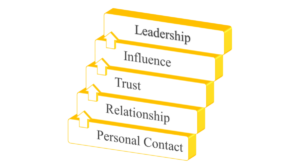Companies with highly engaged employees are 21% more profitable than those with low engagement. What’s more, 70% of employee engagement can be attributed to the skills and behaviors of their leader. So if you want to drive success and exceed your KPIs, it is pivotal to understand and perform the key behaviors of exceptional leadership. Here are 4 impactful leadership behaviors that will help you and your team to succeed in 2022.
Leadership Behavior 1: Doubling Down on Personal Contact
The great paradox of 2022 is that we are simultaneously becoming both more connected and less connected than ever. For many, work has gone remote and may never go back. At the same time, technology has provided us with endless platforms and opportunities for digital connection and communication. As a leader, this presents unique challenges. How do we build cohesion and get everyone moving in the same direction? How do we make everyone feel seen, heard, and respected? How do we tap into the collective power of teams? How do we build deep, meaningful relationships and trust?
The key is doubling down on personal contact…and maybe even tripling down if your team is working remotely. By personal contact, we mean being together in person if at all possible. If it is not possible, a video call is next best. If a video call is not an option, a phone call is the last resort. The point is this: there is something uniquely important about sharing space – physical or virtual – with someone. At TIG, we rely on a framework called the Leadership Ladder:
Personal contact is the building block of trust. Trust leads to influence, and influence is the essence of leadership. Without personal contact, the ability to lead fades away.
Go out of your way to initiate contact. Connect on things outside of the issues at work. Show compassion, empathy, and curiosity. Be human together. And watch your employees become more engaged, more fulfilled, and more successful.
Action Steps:
- MBWA, Management By Walking Around, is well known for a reason: it works. Make a list of each person in your world and determine when a good time to connect with them would be, put it in your daily plan, and do it.
- If you are working in the office, make every trip to the watercooler an excuse to stop by someone’s desk and connect. Even a 30 second conversation can make an impact.
- Utilizing personal contact to strengthen relationships is almost useless without actively listening. Before the interaction, take a moment to switch yourself off “transmit mode” and into active listening.
- Asking good questions can put you into active listening mode. It doesn’t hurt to think of these questions in advance – it can still come off casually even though you have prepared.
Leadership Behavior 2: Personalize Motivation Strategies
We like to say that leaders are in the gas delivery business. It is a leader’s job to provide energy, motivation, and inspiration to his or her team. The problem is that, just like cars, everyone runs most smoothly on a different type of fuel. Some vehicles take regular unleaded, some take premium, some take diesel. Some people are motivated by praise, some need hard deadlines, some need to be challenged. If you put the wrong type of gas in the car, it is not going to run properly. The same is true of people.
So how do you know what motivates each of your teammates? The answer is simple: ask them! This is a critical step that most leaders miss, often giving everyone the same type of fuel. By asking your people what motivates them, it will not only provide you with a roadmap for bringing out their very best, but also show them that you genuinely care about them as a person. The rest is simple: consistently and reliably deliver the gas they have already told you they need.
Action Steps:
- Sit down with your people and ask what motivates them. This can be a great time to engage in a broader conversation about leader development: how they want to grow, where they want to go in the organization, and what they want to do more of.
- You may hear, “I don’t know!” Some people, usually younger people in the workforce, haven’t fully figured out what motivates them yet. That’s ok, keep asking good questions to help lead their thought process. You can also try experimenting with different motivational techniques and see what sticks. You can never go wrong with appreciation, quality communication, and empowered decision making.
Leadership Behavior 3: Maintain Situational Awareness
A few years ago, our team at TIG took 20 years of leadership assessment data from over 4,000 assessments and analyzed it to see if we could find any interesting insights that could help our clients. One of the most interesting things we found was the strong correlation between achieving results and situational awareness – the ability to have an accurate, well-rounded understanding of your current circumstances. The leaders that consistently produced the strongest results were the ones who started with the clearest picture of their situation.
In 2022, we have access to more data and analytics than ever before. Our collective situational awareness should theoretically be on the rise. However, in our experience with clients, we’ve actually found just the opposite. Leaders are increasingly unaware of other key components of their situation – most notably, the internal states of their employees. With remote work a fact of life, it is harder and harder to know where employees stand on issues, how employees view the leaders within an organization and their initiatives, and how engaged employees are with their work.
This makes it especially important for leaders to go out of their way to develop systems for gaining situational awareness about their people. Great leaders ask great questions. Schedule check-ins, ask good questions, and listen carefully. Actively seek feedback and encourage constructive criticism. Use the information that you learn to drive growth and drive results.
Action Steps:
- Always be thinking about the three questions for situational awareness: What’s happening? What’s not happening? What can I do to influence the situation?
- Build a system for gaining situational awareness. What is the most important information and data you need to know and monitor to do your job well? Determine what people you need to be in touch with and how often. Determine what information can be gained through electronically automated measurement for speed and efficiency.
Leadership Behavior 4: Managing Your Emotions
Leadership is an inside out game. Your ability to effectively manage your thoughts, emotions, and attention is an integral part of showing up fully for those around you. Stress, pressure, and other difficult emotions are an inevitable part of life, especially in the volatile times that we are currently facing. What is not inevitable is letting these emotions hijack your decision making processes and the way you treat those around you. If your emotions are managed appropriately, they can be an asset rather than an impediment.
One of the most effective and proven ways to manage your emotions is through the practice of mindfulness. Mindfulness practice can be thought of as going to the mental gym, with various exercises that target different “muscle groups” of your mind. There are practices for focus, compassion, decision making, relaxation, and more. There is significant scientific research demonstrating their potential to increase your competency in each area. Navy SEALS, professional athletes, and high-performers across the globe also use mindfulness techniques to drive peak performance.
Spending just a few minutes per day on a simple mindfulness practice can go a long way in helping you to regulate your emotions and have them work for you, not against you. In the high-stress, high-pressure environment that many of today’s leaders operate in, leading without mindfulness is like stepping onto an NFL football field without spending any time in the weight room. As leaders, our most valuable asset is our mind and we owe it to ourselves and our colleagues to train it to the best of our abilities.
Action Steps:
- Practice mindfulness techniques BEFORE you need to be mindful! The positive results will only come after this habit has strengthened your mind muscle!
- Avoid communicating and making decisions when your brain is emotional or in “fight or flight” survival mode. The critical creative thinking from your prefrontal cortex won’t be engaged and you won’t be at your best. Take time away from the issue to relax, even as little as a couple minutes, before reengaging. This rule applies double for emails!
- Focus on repetition not duration. One mindful breath daily can be more beneficial than one 10 minute meditation weekly. The more times you take that step into mindfulness, the quicker you will build the habit.
- Download a mindfulness app like Headspace, Calm, or Insight Timer. These can be a great companion for your mindfulness growth with gentle reminders and engaging ways to practice.



